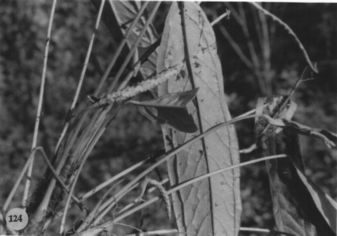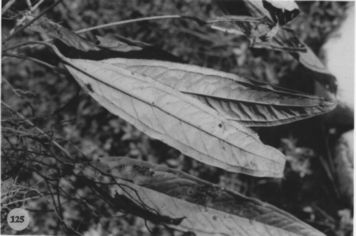





Anthurium pallens Schott,
Oesterr. Bot. Z. 8: 180. 1858. TYPE: Costa Rica, near Desengano, 2,600 m. Wend/and 840 (GOET).
Epiphyte, scandent; internodes 5-9 mm long; cataphylls 4.5-5 cm long, drying reddish-brown, weathering into linear fibers and persisting.
LEAVES erect-spreading; petioles subterete, 7-25 cm long, 2.5-6.5 cm diam., narrowly sulcatc; blades lanceolate-linear to narrowly oblong-elliptic, 18-34.5 cm long, 2.5-6.5 cm wide, long-acuminate at apex, acute to obtuse or rounded at base; midrib raised above and below; primary lateral veins 5-9 per side, sunken above, raised below; lesser veins inconspicuous; collective vein arising from near the base.
INFLORESCENCE ± erect, shorter than leaves; peduncle 10-16 cm long; spathe green, lanceolate, 2.5-3.2 cm long, 0.8-1 cm wide; spadix green turning yellow (sometimes orange), 3-4.5 cm long, 3-6 mm diam. (dry) at base, weakly tapered at apex; the flowers rhombic, ca. 3.1 mm long, 3 mm wide (dry); ca. 3 flowers visible in the principal spiral, ca. 5 flowers visible in the alternate spiral.
INFRUCTESCENCE with spadix to 6 cm long; berries green to yellow-green
(?), ± globose. Figs. 124 and 125.
Anthurium pallens is known from Costa Rica and Panama at 1,000 to 2,000
m elevation in premontane rain forest and lower montane rain forest life zones.
Anthurium pallens is easily confused with A.
microspadix with which it shares similar habitats. It differs from A.
microspadix by having blades acute to rounded at the base and clustered
at the ends of relatively short branches with short internodes. It also has
longer petioles and blades that dry characteristically gray-green and weakly
glossy on the lower surface. Anthurium microspadix has long internodes
with the leaves more widely and regularly spaced and blades that are rounded
to subcordate at the base and generally matte on the lower surface upon drying.
While both species may be epiphytic, A. microspadix generally is rooted
in the soil and is an erect or semierect, vine-like plant, reclining or using
trees for support. Anthurium pallens is usually a short-stemmed epiphyte
that is frequently pendent.
Although mature berries have not been seen, they are no doubt yellowish-green
and subglobose like those of A. microspadix. The species is a member
of section Xialophyllium.
 |
 |
Costa Rica Costa Rica: 2600 m,, 9 May 1857 ?, Wendland 840 (GOET).
Costa Rica Heredia: 2060 m, 10.11N 84.07W, 14 April 1986, Michael H.
Grayum 7089 (MO).
Costa Rica Heredia: Parque Nacional Braulio Carrillo, 2500 m, 10.07.22N
84.07.15W, 20 June 1990, Varela 142 (MO).
Costa Rica Heredia: 2000 m, 10.10N 84.06W, 5 April 1988, B.A. Loiselle
368 (MO).
Costa Rica Heredia: Volcán Barba,, , Brade 2511 (BR).
Costa Rica Heredia: 2000 m, 10.06N 84.03W, 25 Oct. 1975, Burger, W.
& R. Baker 9481A (MO).
Costa Rica Heredia: 1600-1800 m, 10.04N 84.01W, 6-7 Feb 1977, Burger,
W. et al. 10268A (MO).
Nicaragua Jinotega: 1200 - 1400 m, 13.17N 085.40W, 24 julio 1997, Ricardo
Rueda & Indiana Coronado 6889 (MO).
Nicaragua Jinotega: 1200 - 1400 m, 13.17N 085.40W, 24 julio 1997, Ricardo
Rueda & Indiana Coronado 6921 (MO).
Nicaragua Jinotega: 1200 - 1500 m, 13.17N 085.41W, 25 julio 1997, Ricardo
Rueda & Indiana Coronado 7012 (MO).
Panama Chiriquí: 1800-2200 m, 08.49N 82.23W, 7 Feb 1986, Michael H.
Grayum 6405 (MO).
Map of South American Specimens with coordinates
Ecuador Los Ríos: 300-400 m, 00.36S 79.18W, 01 July 1977, Iltis et al. E-95A (SEL,WIS).